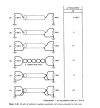You are taking generic concepts and assuming they are consistent at all frequencies and assuming homogenous fields which rarely are.
This is the good thing with fundamental Physic concepts if they fundamental they are consistent.
Like Kirchhoff's law or in this case Ampere's law and Biot-Savarts law
Anyways we can calculate the magnetic flux trough a infinitely small slice of cable.
in fact this is a very typical first or second semester task.
The TL;DR is on the outside of the cable the magnetic is 0 and therefor the influence from magnetic fields to the cable is also 0
And this is True for a mall slice of the cable as well as for a long cable no matter if bend coiled up.
Now do this for a Twisted Pair cable. the filed around a slice of the cable is not 0 but if you
integrate over the length of one twist it cancels out...
But only if it's a homogeneous field over the length of one twist
If your talking about the case wen the currents on the cable are not Equal with opposite direction (for example if there is a ground loop)
Both coax and twisted pair will perform badly because in this case geometric center is way outside the Cable and loop area is bigger
How will it perform in this case:
page 16
This should also show why Ferrits can drastically improve performance by increasing LS.
www.kimber.com




 )
)